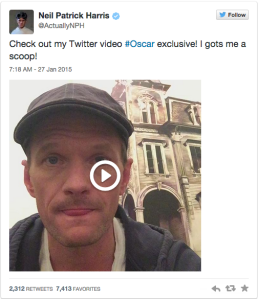The following post was written by guest blogger David Neuman. Please read his bio after the post.
2014 brought a lot of significant changes to the biggest Social Network in the world ranging from auto-playing videos to completely moving their messaging feature to a separate application to continuing to decrease brands’ organic post reach. While some of these changes only impacted a small percentage of users, there will likely be some big changes in 2015 that will have a significant impact on brands. Here are five things brands can expect from Facebook in 2015.
Continuing to Pay for Post Reach: This is nothing new and something that has been effecting brands for a couple of years now. However, this will likely get even worse in 2015. Facebook is starting to crack down on posts that are overly self-promotional or are too advertorial; significantly decreasing their reach (or not showing them altogether). This change, combined with the expected increase in ad spends for news feed posts in 2015, will result in a large amount of brands having to pay for their posts to see any worthwhile reach. I expect many small businesses to increase their focus on other channels like Instagram and Twitter as a result.
Being Able to Advertise Based on Searches & Post Keywords: More of a prediction than something that’s guaranteed for 2015, but it makes sense given Facebook’s recent changes to their internal search engine and the fact that they have removed Bing listings from their search results. Facebook is now allowing users to search for a specific post by keyword and also is showing their most recent searches on their mobile application. Keyword bidding is highly successful on Twitter and would likely see similar success on Facebook. If you’re a seafood restaurant, for example, imagine being able to target users who post “I’m craving seafood”, or who are searching on Facebook for “seafood restaurants”, that are in close proximity to your restaurant.
Call to Actions on Facebook Pages: This has started to roll out for some brands and is expected to roll out to all pages in the coming weeks. Instead of having just “like” and “message” appear over a page’s cover images, brands will now be able to add call to actions such as “book now”, “contact us”, “use app”, “play game”, “shop now”, “sign up”, and “watch video”. When this is clicked on, it will redirect the user to an external URL and will alert page admins on the amount of call to action clicks that have taken place. Tip: do what the page below did and drive people to “click” through your cover image design.

Video will be a Crucial Part of a Brand’s Content Strategy: Facebook has been heavily pushing video and it shows. According to Facebook, users are posting 75% more videos to Facebook directly than they did a year ago and that, between June 2014 and September 2014, users collectively averaged 1 billion video views on Facebook each day. Facebook also recently acquired video compression company Quickfire in January 2015 and video ad platform LiveRail in July 2014. We’ve seen for our clients video getting more organic reach on the news feed than other post types. Instead of promoting YouTube content on Facebook, brands should start to upload their video content directly onto Facebook.
Advertising and Content Strategy will Prioritize Mobile: It’s no surprise that mobile usage is rapidly growing on Facebook – both on the ad front and in overall usage. Ad campaigns and brands’ overall content strategies will need to continually think about how what they’re doing translates on mobile devices heading into 2015 or they will be missing out on lost opportunities. Besides the obvious of making sure your website is “mobile friendly”, make sure the messaging you include in your ad creative and post content resonates with a mobile audience.
-Post by guest blogger David Neuman-
 David has been with Prime Visibility for over 7 years and has over 9 years’ experience in Digital Marketing. He manages Social Media initiatives for the company where he creates and executes Social Media strategies for the agency’s clients. David was also the recipient of two LISTNet awards for developing an algorithm to measure the virality of Social Media campaigns and has appeared on CNBC and WSJ Live.
David has been with Prime Visibility for over 7 years and has over 9 years’ experience in Digital Marketing. He manages Social Media initiatives for the company where he creates and executes Social Media strategies for the agency’s clients. David was also the recipient of two LISTNet awards for developing an algorithm to measure the virality of Social Media campaigns and has appeared on CNBC and WSJ Live.
 This week Twitter announced some much-anticipated new features that it hopes will provide a richer, more immersive experience for users.
This week Twitter announced some much-anticipated new features that it hopes will provide a richer, more immersive experience for users.

